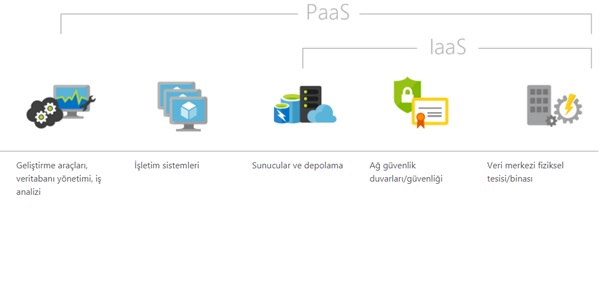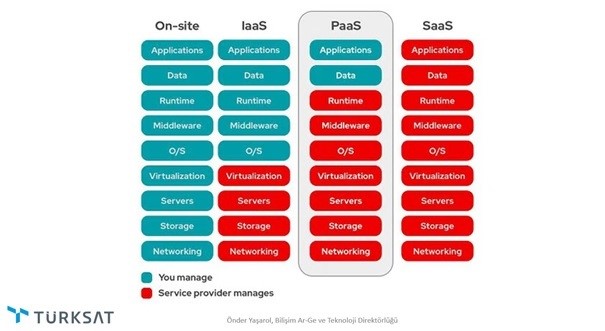In today's rapidly evolving digital world, businesses face enormous pressure to develop scalable, innovative and agile methods. Businesses often meet the changing needs of their customers or in projects they have developed for themselves; They need to build, test and release their applications quickly. However, responding to all these requests quickly or implementing the innovative solutions they want can be both very time-consuming and financially expensive. This is where the concept of "Platform as a Service" comes into play. In this article, we will discuss what Platform as a Service (PaaS) is, how it works, usage scenarios and what benefits it provides for businesses.
Cloud Computing and Platform as a Service (PaaS)
What is Platform as a Service (PaaS)?

Platform as a Service (PaaS); It is a cloud computing service model that offers businesses software development environments, testing platforms and tools, and various services and tools to commission their applications for the applications and projects they have developed. With the PaaS service model, businesses do not need to think about issues related to the management of the hardware (server, disk, and other components) and service infrastructure on which their software runs, and do not need to plan time and resources in these areas. Because the operating system on which their applications run, and all of the hardware and service infrastructure components we just mentioned are provided and managed by the cloud service provider. In this way, by focusing only on software development processes, they can save time and budget, and they can easily develop and quickly publish their applications with the various software development and management tools provided by the cloud service provider.

To summarize in simpler terms, PaaS; To build, publish and automatically scale when necessary, a business's or a software developer's applications, including server and hardware infrastructure, software development tools, middleware, operating system and database infrastructures (increasing system hardware resources both numerically and component-wise etc.) is an end-to-end managed platform that provides everything they need as a service. It is generally offered as a subscription and usage-based service by cloud computing service providers and can be easily accessed and managed from the web browser and management interface.
How does it work?
By administratively separating the application development environment and the system hardware infrastructure environment, PaaS offers businesses the platform necessary to develop and easily publish their applications, ready for use. Although software development and system hardware-infrastructure environment are indispensable for each other, in the PaaS cloud computing service model, you do not worry about the back-end system infrastructure components and how to manage them while developing your code, and you do not make any effort for this. After determining the architecture of the project, such as in which software language you will develop the application, which services and database management system you will use in the back layer; All of these services are offered to you ready-to-use by the cloud computing provider, and the management workload of these systems is entirely on the cloud computing service provider. On the cloud computing service provider side, most of these processes are carried out automatically and in a healthy way with various automation tools. Servers, storage units, network communication management and databases are managed by the cloud computing service provider, ensuring that the platform is highly accessible, uninterruptedly available, scalable and secure. This allows businesses to keep their focus solely on software development, reducing the burden of managing the system and hardware-infrastructure side.
Benefits of Platform as a Service (PaaS)
- Faster time to go live: Platform as a Service provides businesses with pre-built software development tools, middleware and infrastructure, enabling them to build and deploy their applications faster and get them live faster.
- Low cost: PaaS is a cost-effective solution because businesses pay only for what they use (pay-as-you-go). The need to invest in expensive hardware and software is eliminated. In addition, since the management of this hardware and infrastructure is completely done by the cloud computing service provider, there is no relevant operational cost on the business side.
- Scalable: In the Platform as a Service (PaaS) cloud computing model, systems are designed to be highly scalable, allowing businesses to quickly increase or decrease resources according to the resource usage intensity in their applications.
- Diversity and Flexibility: Provides a variety of options for software developers to choose the development tools and programming languages that best suit their needs. This enables them to develop and launch their applications comfortably and smoothly, using the technology and programming languages they master most.
- Collaboration: enables members of the project team to work simultaneously and jointly on the same project, regardless of their location. Additionally, thanks to the compatibility of the cloud computing platform with various DevOps tools, it streamlines workflows.
- Easy management: PaaS cloud computing platforms are designed to be easy to use and manage. It has a user-friendly interface that allows users to easily manage their applications and projects and develop their applications comfortably without getting bogged down in technical details.
- Security: Cloud computing platforms use various security systems against cyber-attacks. By incorporating industry-standard security solutions such as firewall, intrusion detection, anomaly detection and high encryption into its systems and infrastructures, it makes its systems and customers' data highly secure against cyber-attacks.
Uses of Platform as a Service (PaaS)
To mention some of the usage areas where the Platform as a Service cloud computing model is used, these are;
Application development and deployment: The PaaS cloud computing model is widely used to develop applications and release them. Businesses can quickly develop, test and easily publish their applications thanks to the various tools and infrastructure provided by the PaaS platform. In this way, the time to bring their projects (applications) to market is significantly shortened.
Mobile application development: Cloud computing service providers offer various tools and services to develop mobile applications for different mobile operating systems such as iOS and Android.
Big data analytics: Thanks to their large system infrastructures, cloud service providers offer a variety of tools and services to process and analyse large volumes of data, providing great convenience to their customers in terms of data-based decision mechanisms and significantly reducing organizational costs in this area.
Internet of Things (IoT): Cloud service provider platforms offer a variety of tools and services to build and manage IoT applications, such as data collection and analysis, device management, and communication of devices with each other.
Known Service Providers Offering Platform as a Service (PaaS) Model
- Microsoft Azure: Microsoft is a cloud computing service provider that provides many services, including PaaS, for businesses of all sizes.
- Amazon Web Services (AWS) Elastic Beanstalk: It is a fully managed PaaS platform that allows businesses to develop and publish their software in the best possible way, easily and quickly.
- Google App Engine: Likewise, like Microsoft and Amazon, Google provides a fully managed PaaS platform that allows businesses to easily develop and release their software.
- Heroku: Likewise, Heroku is a cloud computing-based service provider that allows businesses to easily and quickly develop and deploy their software on Heroku's infrastructure.
As Turksat Bilişim, in order to take firm steps forward in the sector, our R&D studies on our self-developed cloud computing platform in the field of cloud computing continue. In order to offer the PaaS (Platform as a Service) service model on this platform, R&D and testing studies of our container architecture-based PaaS platform, which we are developing using open-source software, continue.
Conclusion
Platform as a Service (PaaS); It is a cloud computing service model that provides a complete software development environment and applications for businesses. PaaS allows businesses to create and deploy their applications quickly and easily, without worry, by eliminating the costs and efforts of managing hardware infrastructure and resources, focusing only on software development processes. It is a cost-effective and flexible solution that offers several benefits including faster time-to-go, scalability, security and easy management. PaaS cloud computing service providers offer a wide range of tools and services that make it easy for software developers and businesses to build and deploy their applications, thus ensuring their customers do not face platform restrictions. With the rise of cloud computing trends, the PaaS service model; It is becoming a basic need day by day for businesses to remain agile, innovative and competitive in the sector.
Önder Yaşarol
IT Software Development Specialist (DevOps, Cloud Computing)
Informatics R&D and Technology Directorate

